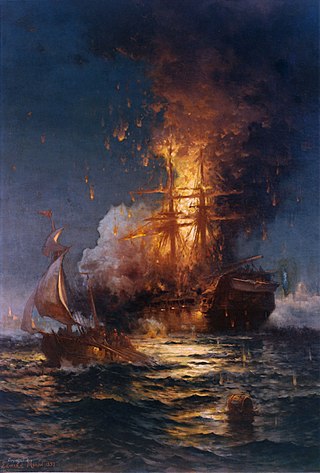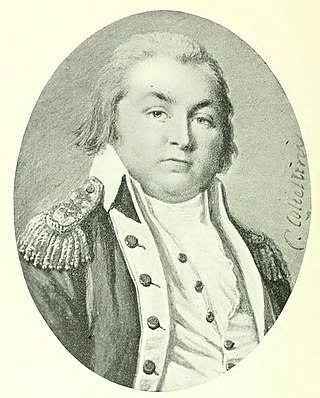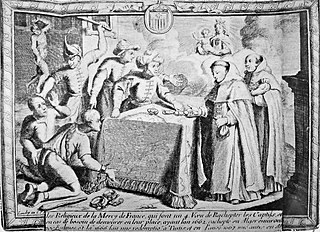
The Barbary Wars were a series of two wars fought by the United States, Sweden, and the Kingdom of Sicily against the Barbary states and Morocco of North Africa in the early 19th century. Sweden had been at war with the Tripolitans since 1800 and was joined by the newly independent US. The First Barbary War extended from 10 May 1801 to 10 June 1805, with the Second Barbary War lasting only three days, ending on 19 June 1815. The Barbary Wars were the first major American war fought entirely outside the New World, and in the Arab World.

The Second Barbary War, also known as the U.S.–Algerian War and the Algerine War, was a brief military conflict between the United States and the North African state of Algiers in 1815.

The Barbary pirates, Barbary corsairs, or Ottoman corsairs were mainly Muslim pirates and privateers who operated from the largely independent Ottoman Barbary states. This area was known in Europe as the Barbary Coast, in reference to the Berbers. Slaves in Barbary could be of many ethnicities, and of many different religions, such as Christian, Jewish, or Muslim. Their predation extended throughout the Mediterranean, south along West Africa's Atlantic seaboard and into the North Atlantic as far north as Iceland, but they primarily operated in the western Mediterranean. In addition to seizing merchant ships, they engaged in razzias, raids on European coastal towns and villages, mainly in Italy, France, Spain, and Portugal, but also in the British Isles, the Netherlands, and Iceland.

The Bombardment of Algiers was an attempt on 27 August 1816 by Britain and the Netherlands to end the slavery practices of Omar Agha, the Dey of Algiers. An Anglo-Dutch fleet under the command of Admiral Edward Pellew, 1st Viscount Exmouth bombarded ships and the harbour defences of Algiers.

The Regency of Algiers, a largely independent early modern Ottoman tributary state on the Barbary Coast of North Africa between 1516 and 1830, was founded by the corsair brothers Aruj and Hayreddin Barbarossa. The Regency was an infamous and formidable pirate base that plundered and waged maritime holy war on European Christian powers. It was ruled by Ottoman regents as heads of a military oligarchy of janissaries and corsairs.

James Leander Cathcart was an American diplomat, slave, and sailor of Irish descent. He is notable for his narrative as a slave in Algiers, Ottoman Algeria, for eleven years.

The conquest of Tunis occurred in 1535 when the Habsburg Emperor Charles V and his allies wrestled the city away from the control of the Ottoman Empire.

The Barbary slave trade involved the capture and selling of European slaves at slave markets in the largely independent Ottoman Barbary states. European slaves were captured by Barbary pirates in slave raids on ships and by raids on coastal towns from Italy to the Netherlands, Ireland and the southwest of Britain, as far north as Iceland and into the Eastern Mediterranean.
USS Spitfire was the former Baltimore privateer Grampus that the United States Navy purchased. She was a heavily armed schooner built for service in the War of 1812, but did not see service until the Barbary Wars when she was sent with the American fleet to the Mediterranean to force an end to piracy of American ships.

Anglo-Turkish piracy or the Anglo-Barbary piracy was the collaboration between Barbary pirates and English pirates against Catholic shipping during the 17th century.

Hamidou ben Ali, known as Raïs Hamidou, or Amidon in American literature, born around 1770, and died on June 17, 1815, near Cape Gata off the coast of southern Spain, was an Algerian corsair. He captured up to 200 ships during his career. Hamidou ensured the prosperity of the Deylik of Algiers, and gave it its last glory before the French invasion. His biography is relatively well known because the French archivist Albert Devoulx found documents that told of this charismatic character.

Ali V Ben Ahmed, nicknamed Ali Khodja, Ali-Meguer, or Ali Loco was a Kouloughli of partial Georgian (Mengrelian) and Native Algerian origins born in Algeria. He was the dey of the Deylik of Algiers from September 1817, just after the assassination of his predecessor Omar Agha the 8th. He remained so until his death in February 1818. His sobriquet Ali-Meguer may indicate his Mingrelian background.

Haji Ali ben Khrelil was Dey of the Deylik of Algiers from 1809 - 1815.

The bombardment of Algiers in 1683 was a French naval operation against the Regency of Algiers during the French-Algerian War 1681–88. It led to the rescue of more than 100 French prisoners, in some cases after decades of captivity, but the great majority of Christian captives in Algiers were not liberated.

The French-Algerian War of 1681–1688 was part of a wider campaign by France against the Barbary Pirates in the 1680s.
The Shipwreck of Dellys took place in May 1830, during the French conquest of Algeria. It involved French troupes coloniales, under captains Félix-Ariel d'Assigny (1794-1846) and Armand Joseph Bruat (1796-1855), who were captured by the resistance fighters of the town of Dellys in Kabylia of the Igawawen.
Mohamed ben Hassan, also known as Muhammad III was during the reign of Baba Ali Chaouch khaznaji of Algiers before becoming Dey of Algiers from 1718 to 1724 as successor to Baba Ali I.

The ta'ifa of raïs or the Raïs for short, were Barbary pirates based in Ottoman Algeria who were involved in piracy and the slave trade in the Mediterranean Sea from the 16th to the 19th century. They were an ethnically mixed group of seafarers, including mostly "renegades" from European provinces of the Mediterranean and the North Sea, along with a minority of Turks and Moors. Such crews were experienced in naval combat, making Algiers a formidable pirate base. Its activity was directed against the Spanish empire, but it did not neglect the coasts of Sicily, Sardinia, Naples or Provence. It was the taifa which, through its seizures, maintained the prosperity of Algiers and its finances.

Dey Hadj Ahmed Chabane was the fourth Dey of Algiers. He ruled from 1688 to 1695, and was the first member of the Algerian Janissary Odjak to ever assume this position. Under his leadership, Algeria enjoyed good relations with France. His military campaigns against Morocco and Tunis were successful. However, his enemies turned his Eastern army against him; he was removed from power and executed.
History of the Regency of Algiers includes political, economic and military events in the Regency of Algiers from its founding in 1516 to the French invasion of 1830. The Regency of Algiers was a largely independent tributary state of the Ottoman Empire. Founded by the corsair brothers Aruj and Khayr ad-Din Barbarossa, the Regency became involved in numerous armed conflicts with European powers, and was an important pirate base notorious for Barbary corsairs.















